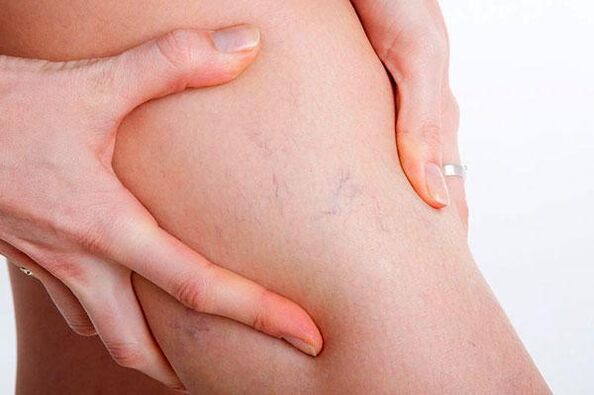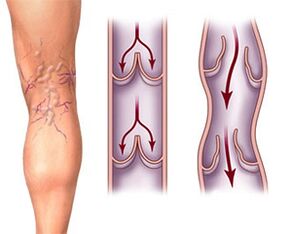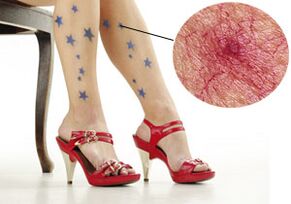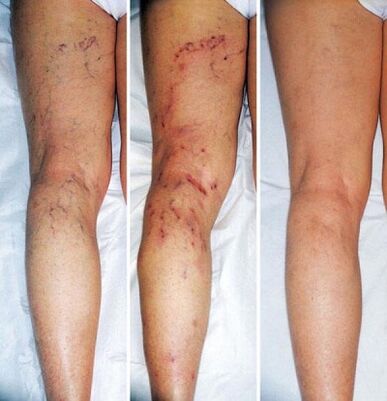
Varicose veins are not only a cosmetic defect that appears on the thighs, legs and upper part of the foot in the form of a blue tree-shaped mesh, accompanied by pain and convulsive contractions in the muscles of the lower part of the foot. the leg when walking or exercising, and heaviness. in the legs. First of all, there is a high risk of thrombosis of the inferior vena cava system. It is a serious illness whose symptoms affect one in four people on the planet.
Thrombotic complications lead to the appearance of trophic ulcers on the legs, acute pathologies of blood circulation and necrosis of the tissues of the lower extremities. Often, a blood clot that breaks away from the wall of a vessel entering the blood circulation system of the lower extremities ends its journey through the human circulatory system in the heart or brain. It is the high risk of stroke or heart attack that is the main factor in starting treatment and preventing varicose veins, and not the unsightly appearance of the legs.
Since its appearance, the disease has continued to progress, affecting new areas of the internal and external venous system of the legs. It would therefore be logical to start analyzing the issue through disease prevention. Competent preventive measures in most cases predetermine the rate of development of pathology, which develops against the background of a hereditary defect of the valvular apparatus of venous blood flow of the legs.
Varicose vein prevention
The walls of the veins of the lower extremities are very weak, the muscular system is designed in such a way that it cannot help but push blood through contractions. To control the directional flow of blood and prevent stagnation, veins have specialized valves. In some people, the valves cannot function properly due to heredity. However, valvular pathology can develop with age due to:
intense physical activity;
increased intra-abdominal pressure;
constipation;
frequent pregnancies.
Initially, the process develops in the external veins, but as the disease progresses, it affects the deep venous network. The process of development of the disease can last decades, and its speed depends on lifestyle, the strength of blood vessel walls and the intensity of physical activity.
The first task of prevention– minimize the increase in intra-abdominal pressure, avoid increased overload and combat constipation.
Second task– promote the passive flow of venous blood from the legs. To do this, there is a technique that must be done at the end of the day, or better yet several times during the day. The essence of the technique is to place straight legs on the surface at an angle of 45 degrees to the horizontal. You should lie in this position for at least half an hour. For people who already have varicose veins, it is recommended to sleep with their legs elevated as often as possible.
If you suffer from any disease, you should not use tight shoes and socks with a tight elastic band, so as not to complicate the already impaired blood circulation.
Also, when performing sedentary work or just sitting for a long time, you should try to give your legs a horizontal position and, if possible, place your legs on an elevation. Naturally, this does not mean that when working in an office you have to sit with your feet on the table. No. Just try putting something under the table that allows you to rest your feet without obstruction when sitting. You should also avoid crossing your legs while sitting. At home, you can elevate your legs by placing several pillows.
Conservative treatment
The non-surgical treatment program includes diet, medication and compression therapy.
Diet

One of the risk factors for developing varicose veins is being overweight. Diet is therefore one of the factors in treatment. Nutrition should be balanced so that the calories received do not exceed the amount required to meet daily needs. Additionally, the number of calories varies depending on the presence or absence of exercise. You should also remove hot seasonings, marinade, pepper, excess salt, alcohol, smoked foods from your diet, and also eat less fried foods.
The menu should include a sufficient amount of vegetables and fruits containing vitamin C, dishes containing a large amount of fiber, seafood and wholemeal bread. Small, frequent meals are recommended. It is important to note that animal fats should be present in moderation. You should not listen to those who say that cholesterol is an absolute evil. Cholesterol in reasonable quantities helps strengthen the vascular walls, thereby reducing the risk of venous ruptures and recurrent thrombotic deposits.
Stop smoking
Smoking is the most harmful habit for varicose veins. The fact is that the tars in cigarettes clog blood vessels, and carbon dioxide causes vascular spasms. Smoking increases the risk of blood clots and, therefore, secondary complications such as heart attacks and strokes. Smoking is especially dangerous for those who, suffering from varicose veins, take hormonal drugs.
Compression underwear (tights, stockings, knee-high socks)
This prevention and treatment option is well suited to the early stages of the disease. Lingerie can be selected based on several parameters of soft tissue pressure, color palette and model option. The underwear is put on in the morning, without getting out of bed, until the veins are overflowing with blood. The main obstacle to using this prevention method is the inflated price. Therefore, the main consumers of knitwear are not those who need prevention, but those who, after surgery, use underwear for the purpose of secondary prevention.
Varicose veins: drug treatment
Medications cannot completely cure or stop the disease.
Venotonics – ointments and gels

Venotonics are aimed at strengthening the walls of veins, stimulating blood flow and slightly improving microcirculation. These medications, taken as a course, can reduce pain and swelling. The treatment is carried out twice a year and lasts at least two months.
Ointments and gels, while safe, are virtually useless. They cannot penetrate further than the skin and therefore affect the condition of blood vessels. Ointments and gels are prescribed in the early stages of the disease, while it is not yet known what can relieve swelling and heaviness in the legs: medication or postural drainage and stopping physical activity. Sometimes ointment manufacturers are cunning and recommend using the product in combination with tablets.
ointment based on the flavonoid rutin.
an ointment based on horse chestnut extract is applied twice a day.
gel whose active substance is an extract of vine leaves. There are also capsules of the drug to take on an empty stomach twice a day.
Venotonics in tablets
Venotonic tablets are used to treat varicose veins.
Saponin derivatives of the drug are obtained on the basis of horse chestnut, which contains the plant bioflavonoid escin. These include the drug, which exists in the form of drops and dragees.
The most effective preparations are made on the basis of a plant flavonoid obtained from citrus fruits - a powerful veinotonic. Treatment with these medications can last up to six months.
Rutosides are the first veinotonics. Their effect is to improve microcirculation and have an anti-inflammatory effect.
Natural rutoside, available in the form of tablets and capsules.
Semi-synthetic rutosides.
Combined rutoside. It combines a semi-synthetic derivative of rutin and a ginkgo biloba extract. The medicine in capsule form is taken twice a day for a month.
Phlebosclerosing drugs
Allows you to exclude veins from blood circulation without surgery. The action is achieved due to the growth of connective tissue, which gradually closes the lumen of the vessel. Connective tissue is stimulated by increased coagulation of endothelial proteins, as well as irritation of smooth muscle of the vessels.
An ointment based on sulfur acid glycosaminoglycan, glucocorticoid and non-ionic surfactant is the simplest option. However, the effect is so weak that injectable solutions are used.
Synthetic phlebosclerotics.
Products containing iodine or based on animal proteins. The medications are used to selectively close small vessels in affected areas of the veins. Among doctors, drugs that do not cause vascular thrombosis are popular,
 They only burn the walls at the endothelial level.
They only burn the walls at the endothelial level.
Phlebosclerosis therapy involves medication injections or elastic bandages. This is a fairly simple and painless technique that does not affect the patient's well-being and is very popular among doctors.
However, isolated sclerotherapy does not provide lasting results and cannot stop the progression of the disease. It is therefore preferable to use it in combination with surgical treatment. Before treatment, it is necessary to undergo an ultrasound scan of the lower extremities to exclude extensive lesions of the saphenous and deep veins.
Contraindications for phlebosclerosis are: allergies to drugs, atherosclerosis of large vessels and the presence of ischemia, endarteritis obliterans, diabetic angiopathy, damage to the blood coagulation system, pregnancy, thrombophlebitisacute in the legs.
Additional medications
Agents improving blood microcirculation: low molecular weight dextrans, purine derivative. These drugs stimulate the breakdown of platelets, reduce blood viscosity and increase the elasticity of red blood cells. These processes improve the blood supply to tissues and their oxidative reactions.
Direct or indirect action anticoagulants. Reduce the risk of thrombosis. Popular products in the form of ointments and gels have anti-edematous, anti-inflammatory and antithrombotic effects.
Nonsteroidal anti-inflammatory drugs – suppress inflammatory processes and relieve pain.
Phlebosclerosing Treatment Options
Before surgery, venous sclerosis is performed to reduce the risk of thrombosis and bleeding in the postoperative period.
During surgery as an alternative to removing veins.
After surgery to close unoperated veins.
The puncture method for drug administration is used at any time, and the catheter method is used exclusively during surgery.
Puncture method
In addition to the operating room, it can only be carried out in a specialized surgical room in compliance with all aseptic rules. The large veins close first, then the small ones. Medications are administered from top to bottom. The vein is pierced with the patient in a vertical position and medications are administered in a horizontal position. If sclerosis of an extensive vessel is necessary, the procedure is carried out in several sessions. After the sessions, the patient is registered with a phlebologist for three years for observation.
After administration of the drug, the limb is subjected to elastic bandaging, which is repeated for two weeks. During the first week, the dressing is not removed.
The patient must walk within half an hour after the procedure.
The patient should sleep with limbs elevated every day and avoid sitting or standing for long periods, as well as walking a lot.
Radiofrequency vein ablation
Venous ablation using a radiofrequency transmitter is a recently emerging area of phlebology. This method allows you to get rid of varicose veins without pain, without complications and with minimal risk of vascular damage. Radiofrequency radiation acts on the inner lining of the vascular wall and destroys it. Thus, the lumen of the vein collapses and the surrounding tissues are virtually unaffected. This is a very effective method.
The procedure is performed under local anesthesia on an outpatient basis. For greater precision during the procedure, control is carried out by duplex angioscanner.
After the anesthetics have taken effect, a venipuncture is performed. A catheter with transmitter is inserted into the vein. It advances to the point where the saphenous vein joins the deep venous system. With the gradual withdrawal of the catheter, sequential irradiation of the vessel occurs from the inside. After the procedure, the puncture site is treated and covered with a bandage. A special elastic stocking is put on the leg. After half an hour of walking under supervision, the patient is allowed to return home. If the patient's work does not involve physical labor, he has the right to work the day after the procedure.
Varicoseextensionveins: operation
The advisability of surgical intervention is examined by a phlebologist or vascular surgeon. For women who need surgery to correct a cosmetic defect, doctors suggest postponing surgery if they are planning to become pregnant. This is due to the fact that during pregnancy varicose veins progress and the effect of the operation can be neutralized.
Combined phlebectomy
The most common option for solving the problem of varicose veins through surgery is combined phlebectomy. The surgical procedure is performed under general or local anesthesia. All incisions are made as small as possible. For example, the great saphenous vein is removed through a one and a half centimeter incision in the groin area. A phlebotomal extractor probe with a special tip is inserted into the vein through the incision. After that, the probe is removed along with the vein. Small veins are removed through small conduits, called mini-phlebectomy. After surgery, you should use compression garments.
Endovasal electrocoagulation
Ablation of the saphenous veins using current. A more dangerous method than radiofrequency obliteration and traditional surgery.
Cryosurgery
Removal of veins by exposure to low temperatures. The method is relatively safe. True, the freezing depth is not always calculated accurately, which leads to damage to adjacent tissues or incomplete removal of the vein.
Intraoperative scleroobliteration
The use of catheter injection of a sclerosing agent into the saphenous veins. Before leg surgery, the saphenous veins and altered areas of the veins are marked. During the operation, the anastomosis of the great saphenous vein and the femoral vein is exposed. The tributaries of the great saphenous vein are ligated. At a distance of 1 centimeter from the femoral vein, the saphenous vein is crossed and ligated. A catheter is inserted into the severed vein, the vein is sutured and the wound is bandaged. A roll of gauze is placed along the projection of the saphenous vein along the entire length of the leg and pressed. Simultaneously with removal of the catheter, a sclerosing agent is injected.
Endoscopic dissection
Phlebectomy by transillumination of the perforating veins allows the veins to be ligated and excluded from the blood circulation. These veins connect the subcutaneous venous network to the deep network. An endoscopic probe is used.
Laser coagulation
The vein is sealed from the inside with a laser and excluded from the blood circulation. Requires a highly qualified physician and sufficient experience with lasers.
Home treatment for varicose veins
At home, varicose veins can be treated with tablets, rubbing ointments, leeches, apple cider vinegar and cabbage leaves. Home treatment can also be carried out while wearing compression garments or elastic bandages. But if the disease is advanced, none of the methods will be effective without surgical treatment.
Today, the only effective way to get rid of varicose veins is surgical methods, as well as cases of combining surgery with sclerotherapy and compression methods.

















